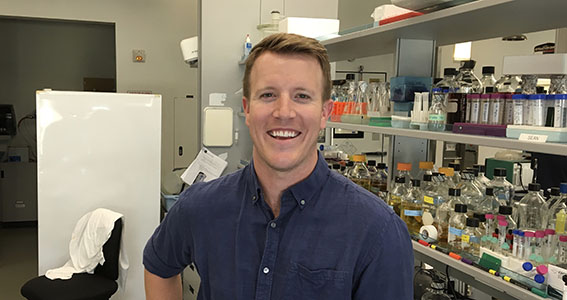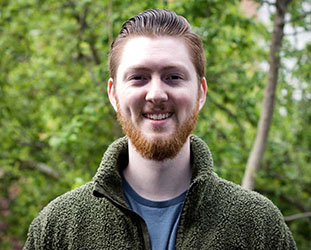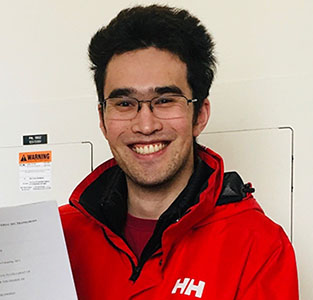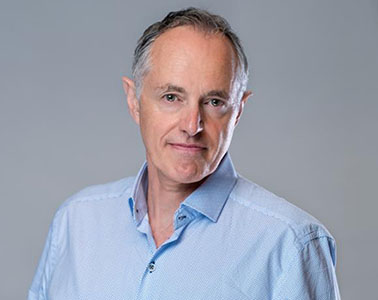 “Structural and Functional Characterizational of Enzymens Central to Bacterial Carrier Lipid Synthesis and Recycling, ” by Sean Workman, Doctoral Candidate, Strynadka Lab
“Structural and Functional Characterizational of Enzymens Central to Bacterial Carrier Lipid Synthesis and Recycling, ” by Sean Workman, Doctoral Candidate, Strynadka Lab
Virtual Exam: Tuesday, March 31, 2020 at 12:30
Posted on May 6, 2020
 “Structural and Functional Characterizational of Enzymens Central to Bacterial Carrier Lipid Synthesis and Recycling, ” by Sean Workman, Doctoral Candidate, Strynadka Lab
“Structural and Functional Characterizational of Enzymens Central to Bacterial Carrier Lipid Synthesis and Recycling, ” by Sean Workman, Doctoral Candidate, Strynadka Lab
Virtual Exam: Tuesday, March 31, 2020 at 12:30
Posted on May 6, 2020
 “Structural insights into the Modulation of Bacterial Peptidoglycan Synthase Activity”, by Nathanael Caveney, Doctoral Candidate, Strynadka Lab.
“Structural insights into the Modulation of Bacterial Peptidoglycan Synthase Activity”, by Nathanael Caveney, Doctoral Candidate, Strynadka Lab.Virtual Doctoral Exam Tuesday, May 26, 2020 at 12:30
Posted on March 16, 2020
 “Exploring the Interactome of the Bacterial Sec Translocon, ” by John Young, doctoral candidate, Duong Lab, UBC.
“Exploring the Interactome of the Bacterial Sec Translocon, ” by John Young, doctoral candidate, Duong Lab, UBC.
Tuesday, April 7, 2020, at 12:30 in LSC 1416, 2350 Health Science Mall
Posted on March 16, 2020
 “Structural Insights into Calmodulin Regulation and Dysregulation of the L-Type Voltage-Gated Calcium Channel,” by Catherine Wang, doctoral candidate, Van Petegem Lab, UBC.
“Structural Insights into Calmodulin Regulation and Dysregulation of the L-Type Voltage-Gated Calcium Channel,” by Catherine Wang, doctoral candidate, Van Petegem Lab, UBC.
Friday, April 17, 2020 at 12:30, Room 200, Graduate Student Centre
6371 Crescent Road
Posted on March 13, 2020

Nicolas Coutin
“Method Development for High Throughput Biology,” by Nicolas Coutin, doctoral candidate, Corey Nislow Lab, UBC
Abstract:
Living things are made from thousands of individual, interacting pieces. To understand these systems, we will need to study many or all the pieces at once. To study biology this way, we will need tools that consider the whole system and how its pieces interact. This work describes methods we developed to study the many components of biological systems at once. It presents a technique that discovers interactions between the molecular machines that act on the genome. This work also demonstrates an application that lets its users analyze thousands of individual experiments interactively.

John Young
“Exploring the interactome of the bacterial Sec translocon,” by John Young, doctoral candidate, Franck Duong Lab, UBC.
Abstract:
Many periplasmic and extracellular Escherichia coli (E. coli) proteins are transported across the inner bacterial membrane through the highly conserved heterotrimeric SecYEG protein-conducting channel. During post-translational translocation, polypeptide substrates are driven across the membrane through SecYEG by the ATPase SecA, which binds to SecYEG and couples nucleotide hydrolysis to polypeptide movement. In the first part of this thesis, we study the dynamics of SecYEG-SecA interactions. We show that SecA is a highly dynamic enzyme, repeatedly binding to and dissociating from SecYEG during substrate translocation. Using two model Sec-dependent protein substrates, we show that the importance of these dynamics for efficient translocation depends on the length of the translocating protein substrate. In the second part of this thesis, we turn to quantitative proteomics to identify novel interactors of the SecYEG complex. Previous studies have identified and validated a series of membrane embedded interactors of SecYEG using classical detergent-based methods. However, it is possible that other important interactors of the Sec translocon may exist which have not yet been identified by detergent-based proteomic methods – the difficulties of using detergent-based methods to identify and characterize transient interactors of membrane proteins and complexes are well-documented. Here, we employ the peptidisc – a “one-size-fits-all” membrane mimetic – to identify and characterize potentially novel interactors of the Sec translocon in detergent-free conditions. One of the most notable interactions identified in this work is a super-complex between the Sec translocon and the outer membrane embedded Bam complex, which is required for insertion of outer membrane proteins (OMPs). This observation is particularly astonishing and has implications for our understanding of outer membrane protein biogenesis. Finally, we develop a functionalized variant of the peptidisc scaffold and demonstrate its utility for isolation of the membrane proteome. As a simple case study, we employ the functionalized peptidisc scaffold to survey changes in the membrane proteome caused by altered gene expression. Potential future applications of the peptidisc membrane mimetic in the fields of membrane protein biochemistry and membrane proteomics will also be discussed.
Monday, March 23, 2020 at 2:30 pm, LSC #3
Posted on March 4, 2020
 Cancelled: “New modalities for interfering with outer membrane biogenesis in Gram-negative bacteria,” by Steven Rutherford, Senior Scientist, Infectious Diseases, Genentech.
Cancelled: “New modalities for interfering with outer membrane biogenesis in Gram-negative bacteria,” by Steven Rutherford, Senior Scientist, Infectious Diseases, Genentech.
Multi-drug resistant bacteria are a global health threat and new strategies are needed to combat them. However, the discovery of novel antibiotics to treat infections by Gram-negative bacteria has been thwarted by the outer membrane, a permeability barrier that excludes cytotoxic compounds from these cells. My laboratory has identified both large and small molecules that interfere with outer membrane biogenesis by targeting the essential proteins BamA and LptD on the bacterial cell surface, thus avoiding the outer membrane penetration problem. These molecules have validated BamA and LptD as potential antibacterial targets and revealed novel insights into the structures and functions of the only two essential outer membrane proteins.
Monday, March 16, 2020, LSC #3 at 2:30
Host: Dr . Franck Duong
Posted on March 4, 2020
 “Tumor cells highjack diverse cellular processes to maintain redox balance”, by Poul Sorensen, Professor, Department of Pathology & Laboratory Medicine, UBC, Distinguished Scientist, BC Cancer Research Centre Johal Chair in Childhood Cancer Research, UBC.
“Tumor cells highjack diverse cellular processes to maintain redox balance”, by Poul Sorensen, Professor, Department of Pathology & Laboratory Medicine, UBC, Distinguished Scientist, BC Cancer Research Centre Johal Chair in Childhood Cancer Research, UBC.
In aggressive sarcomas such as Ewing sarcoma (EwS) and osteosarcoma (OS), the single-most powerful predictor of poor outcome is metastatic disease, highlighting the critical need to identify new factors driving metastasis in these diseases. Metastasis is widely regarded as a very inefficient process, likely due to diverse stress forms that can potentially cull pre-metastatic cancer cells during the metastatic cascade, including hypoxia in primary tumors, anoikis stress in the circulation, and increased oxidative stress at distant organs prior to colonization. Adaptation to such conditions requires rapid stress-alleviating plasticity to confer fitness for metastatic progression, but mechanisms remain elusive. Studies in our laboratory indicate that mitigation of oxidative stress, not only during local invasion at the primary tumor site, but also in the circulation during dissemination, and potentially as part of colonization at distant sites, is critical for childhood sarcoma metastatic capacity. Indeed, EwS and OS cells appear to utilize many different strategies to maintain redox balance, such as the induction of anti-oxidant pathways involving NRF2, or through other mechanisms such as alterations in amino acid transporter systems to facilitate production of glutathione and other anti-oxidants via amino acid metabolism. Some of these pathways are transcriptionally regulated, such as through direct activation by oncogenic transcription factors, while others are regulated through rapid translational activation by pioneer translation factors such as YB-1. Examples of each of these processes will be discussed.
Monday, March 9, 2020 at 2:30 pm, LSC#3
Host: Dr. Eric Jan
Posted on January 29, 2020
 Co-sponsored by Department of Biochemistry and Molecular Biology and the Michael Smith Laboratories.
Co-sponsored by Department of Biochemistry and Molecular Biology and the Michael Smith Laboratories.
“Regulation of Cellular Biochemistry by Liquid-Liquid Phase Separation”, by Dr. Michael Rosen, Professor, Department of Biophysics, University of Texas Southwestern Medical Centre, Howard Hughes Medical Institute.
Monday, March 2, 2020 at 4:00 pm, LSC#2
Host Dr. Joerg Gsponer
Biomolecular condensates are two- and three-dimensional compartments in eukaryotic cells that concentrate specific collections of proteins and nucleic acids without an encapsulating membrane. Many condensates behave as dynamic liquids, and are believed to form through liquid-liquid phase separation (LLPS) driven by interactions between multivalent constituents. Unlike macromolecular machines such as the ribosome, which have discrete subunit stoichiometries and size, condensates can form with a wide range of component stoichiometries, and range in size from hundreds to thousands of nanometers. While the physical mechanisms that promote and regulate LLPS in vitro and in cells are increasingly well understood, the biochemical functions that arise from organization of macromolecules into these meso-scale assemblies are still mysterious in most cases. In my talk I will discuss condensates that are formed by actin-regulatory signaling molecules. I will explain how the molecules assemble into condensates, how this assembly leads to new biochemical functions, and how these functions are controlled by condensate composition. I will also discuss a new direction in the lab focused on understanding how chromatin may be organized by LLPS, and dynamically regulated by various remodeling machineries. These behaviors may contribute to formation of functionally distinct compartments in the eukaryotic nucleus, which are important to processes including gene regulation and DNA repair
Posted on January 29, 2020
 “Method Development for High Throughput Biology,” by Nicolas Coutin, doctoral candidate, Corey Nislow Lab.
“Method Development for High Throughput Biology,” by Nicolas Coutin, doctoral candidate, Corey Nislow Lab.
Monday, March 16, 2020 at 4:00 pm, Room 200, Graduate Student Centre, 6371 Crescent Road
Posted on January 28, 2020
 “Genome folding in development, ” by Alistair Boettiger, Assistant Professor, Stanford School of Medicine, Department of Developmental Biology, Member of Stanford Bio-X, Member of Stanford Biophysics, Stanford University.
“Genome folding in development, ” by Alistair Boettiger, Assistant Professor, Stanford School of Medicine, Department of Developmental Biology, Member of Stanford Bio-X, Member of Stanford Biophysics, Stanford University.
Establishment of different cell types during development requires precise interactions between genes and distal regulatory elements. However, our understanding of what these interactions look like in three dimensions, how they vary across cell types in complex tissue, and how they relate to transcriptional state remain limited. I will describe optical reconstruction of chromatin architecture (ORCA), a microscopy approach to follow the path of DNA in intact nuclei in thousands of cells. We have used this approach to the study the structure of the Hox complex in Drosophila embryos and mouse embryonic stem cells with nanoscale accuracy and genomic resolution as high as 2 kilobases. Simultaneous imaging of nascent transcription allowed direct correlation of DNA folding to RNA expression in single cells. These data can predict functional enhancers by identifying elements whose proximity to a promoter correlate to that promoter’s nascent transcription activity. They also provide new insights into the mechanisms of enhancer-promoter communication. Further, we find extensive cell-type specific 3D folding of the Hox-locus. These distinct folding patterns result in the formation of physical enhancer-promoter domains specifically in cell types containing the active, not inactive, enhancers. I will also describe our work using ORCA in mutant embryos to elucidate the molecular factors which drive this cell-type specific chromatin organization that provides robust control of these critical patterning genes. We believe this approach for high resolution single-cell DNA domain analysis and RNA expression in vivo support a prominent role for 3D chromatin organization in cell identity and will be broadly applicable in other developmental systems.
Monday, February 10, 2020 at 2:30 LSC#3
Host: Dr. Sheila Teves